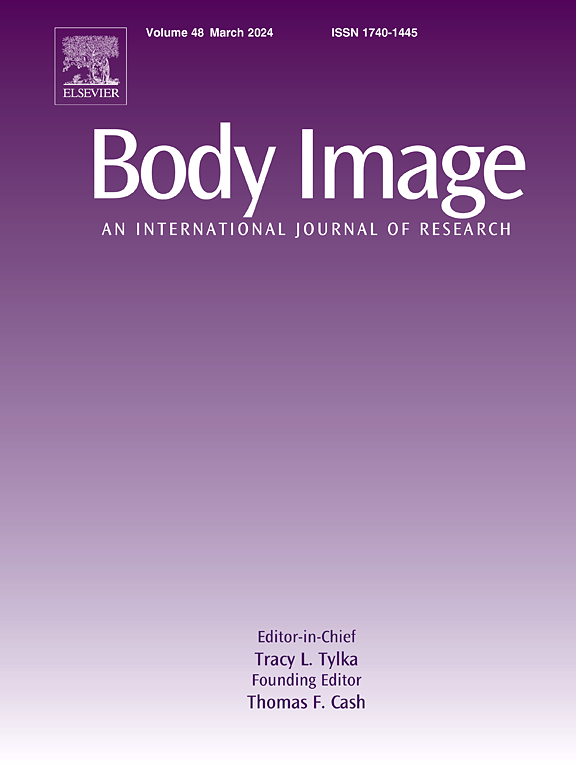Measuring self-objectification in cisgender heterosexual women and men: A psychometric validation of the self-objectification beliefs and behaviors scale
IF 5.4
1区 心理学
Q1 PSYCHIATRY
引用次数: 0
Abstract
Research demonstrates that self-objectification negatively impacts both cisgender heterosexual women and men. However, measures of self-objectification have primarily been designed for and validated in women, raising doubts about their applicability to men and demonstrated gender differences in self-objectification. This research investigated the psychometric properties of the Self-Objectification Beliefs and Behaviors Scale (SOBBS; Lindner & Tantleff-Dunn, 2017) in cisgender heterosexual women, and for the first time, in cisgender heterosexual men. Study 1 (women = 180, men = 163) and 2 (women = 137, men = 138, age-representative samples) used an online longitudinal design. Confirmatory Factor Analysis (CFA) in Study 1 supported the original 2-factor structure of the SOBBS across genders. Multigroup CFA in Study 2 confirmed measurement invariance across genders. Women showed lower latent SOBBS Factor 1 than men, with no gender difference on latent Factor 2. Across studies, the SOBBS demonstrated good concurrent validity, convergent validity, internal consistency and test-retest reliability for both genders, in addition to differentiation by sexual objectification experience. The psychometric properties of the Self-Objectification Questionnaire (Noll & Fredrickson, 1998) and the Objectified Body Consciousness Body Surveillance Scale (McKinley & Hyde, 1996) were also explored. Both scale scores were differentiated by gender after controlling for sexual objectification experience, suggesting that scores on these scales may be subject to gender-based measurement bias. Overall, the current research contributes to the evidence-base for effective measurement of self-objectification in men, indicating that the SOBBS is psychometrically sound for use not only in cisgender heterosexual women, but also in cisgender heterosexual men.
异性恋女性和男性的自我物化测量:自我物化信念和行为量表的心理测量验证。
研究表明,自我物化对异性恋女性和男性都有负面影响。然而,自我物化的措施主要是为女性设计和验证的,这引起了对其适用于男性的怀疑,并证明了自我物化的性别差异。本研究考察了自我客观化信念与行为量表(SOBBS)的心理测量特性;Lindner & Tantleff-Dunn(2017))对顺性异性恋女性的研究,以及首次对顺性异性恋男性的研究。研究1(女性= 180,男性= 163)和研究2(女性= 137,男性= 138,年龄代表性样本)采用在线纵向设计。研究1的验证性因子分析(Confirmatory Factor Analysis, CFA)支持最初的跨性别SOBBS双因子结构。研究2中的多组CFA证实了性别间的测量不变性。女性SOBBS潜伏因子1低于男性,潜伏因子2无性别差异。研究结果显示,性别间的性取向问题量表具有良好的并发效度、收敛效度、内部一致性和重测信度,并存在性物化经历差异。自我物化问卷(Noll & Fredrickson, 1998)和物化身体意识身体监控量表(McKinley & Hyde, 1996)的心理测量学特性也进行了探讨。在控制了性物化经历后,两个量表的得分都被性别区分,这表明这些量表的得分可能受到基于性别的测量偏差的影响。总的来说,目前的研究为有效测量男性自我物化提供了证据基础,表明SOBBS不仅适用于顺性异性恋女性,也适用于顺性异性恋男性。
本文章由计算机程序翻译,如有差异,请以英文原文为准。
求助全文
约1分钟内获得全文
求助全文
来源期刊

Body Image
Multiple-
CiteScore
8.70
自引率
28.80%
发文量
174
期刊介绍:
Body Image is an international, peer-reviewed journal that publishes high-quality, scientific articles on body image and human physical appearance. Body Image is a multi-faceted concept that refers to persons perceptions and attitudes about their own body, particularly but not exclusively its appearance. The journal invites contributions from a broad range of disciplines-psychological science, other social and behavioral sciences, and medical and health sciences. The journal publishes original research articles, brief research reports, theoretical and review papers, and science-based practitioner reports of interest. Dissertation abstracts are also published online, and the journal gives an annual award for the best doctoral dissertation in this field.
 求助内容:
求助内容: 应助结果提醒方式:
应助结果提醒方式:


